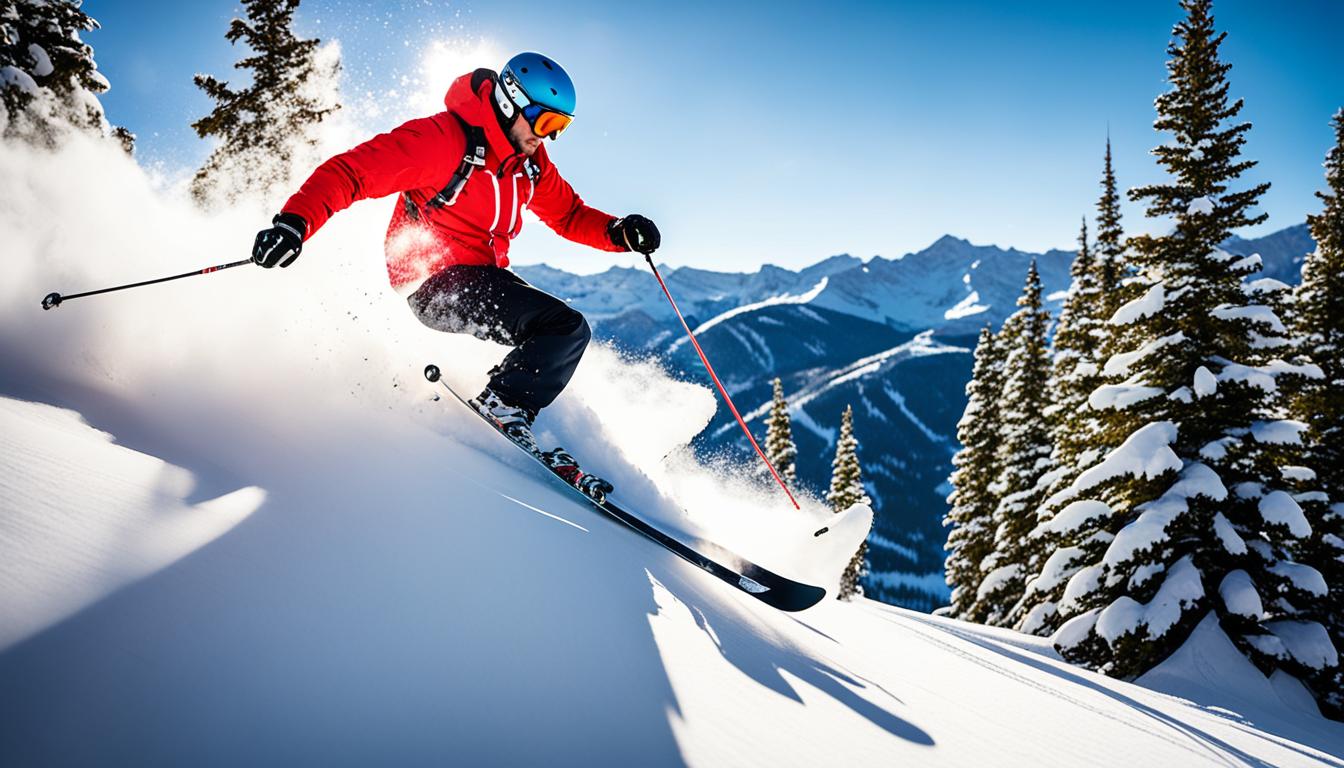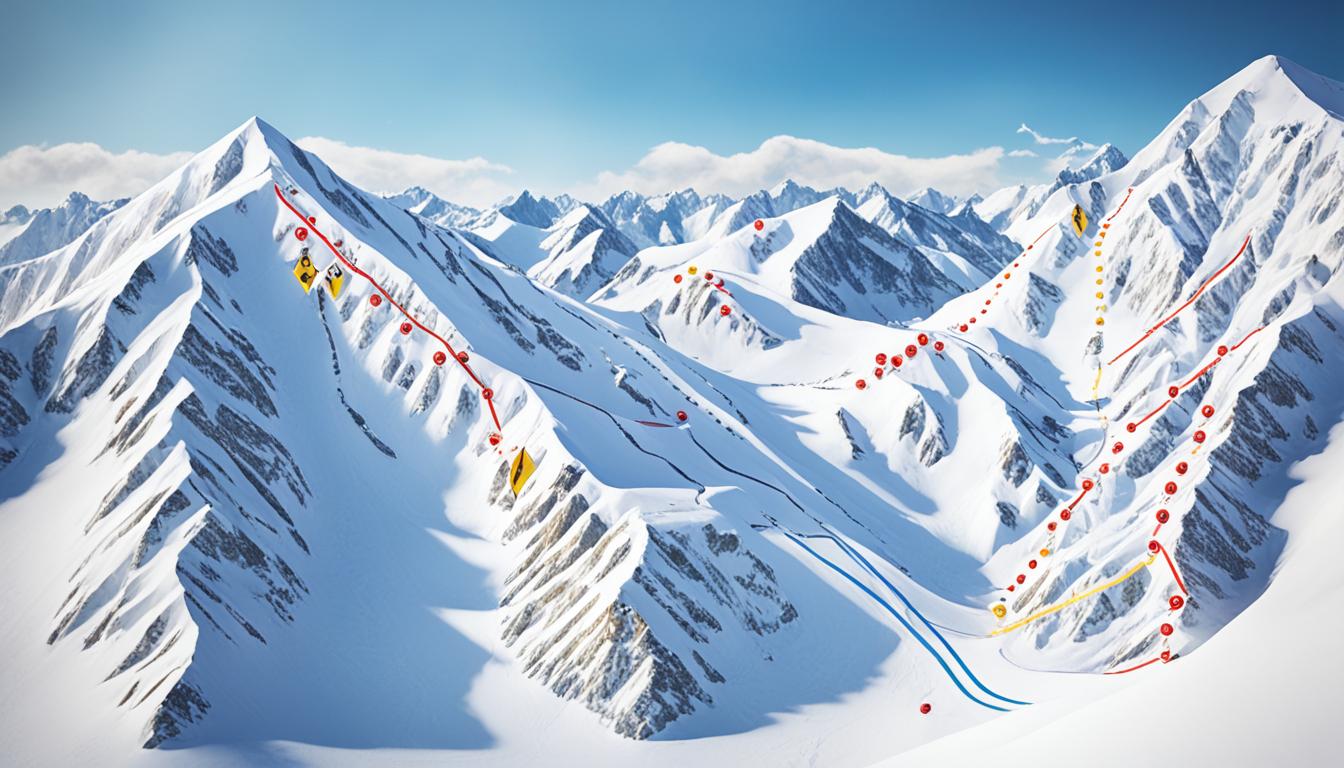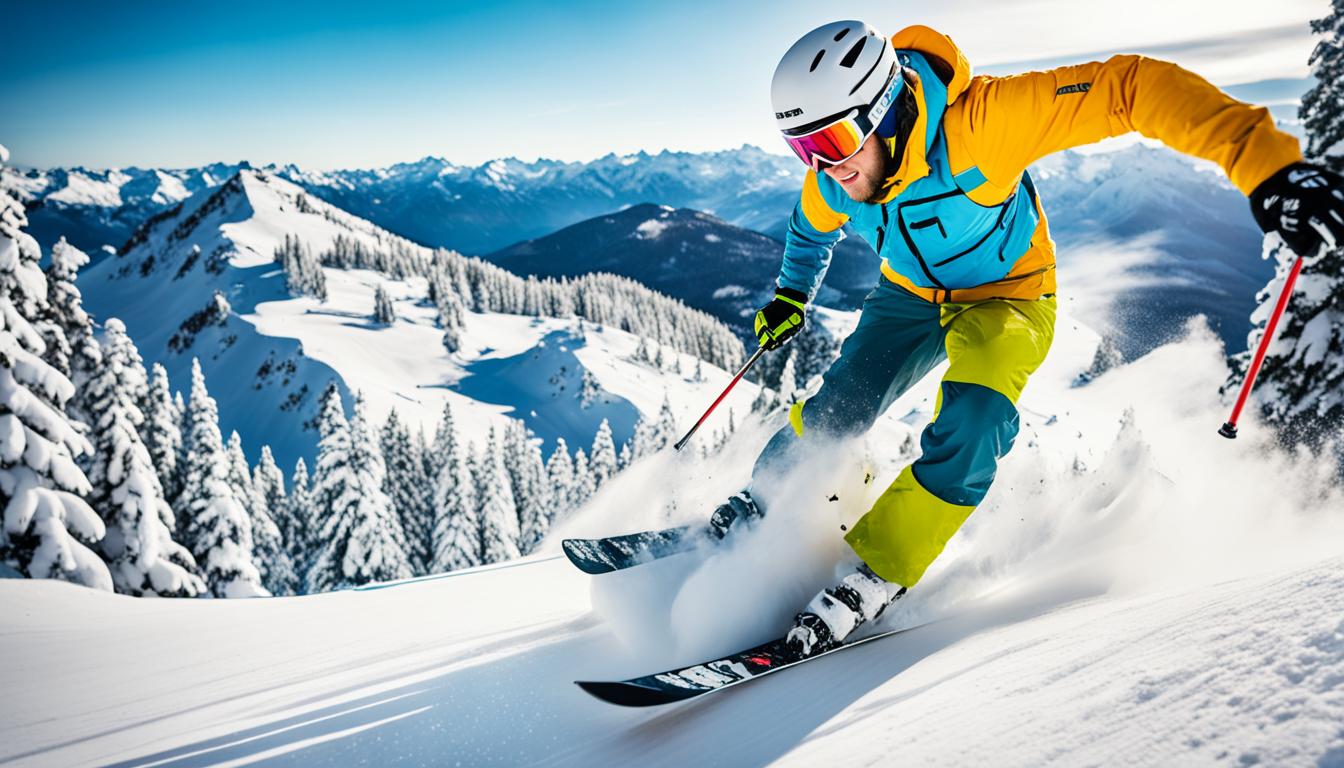Greetings fellow skiing enthusiasts! Today, we embark on a journey to discover the future of ski seasons in the breathtaking state of Colorado. As we strap on our goggles and embrace the powdery slopes, let’s delve into the ski resorts, snowfall trends, and the impact of climate change on this iconic winter wonderland.
Colorado, with its majestic peaks and renowned ski resorts, has long been a haven for winter sports enthusiasts. However, recent studies have brought to light the challenges that lie ahead for this cherished skiing destination. Climate change is a pressing issue affecting ski resorts across the United States, and Colorado is no exception.
Key Takeaways:
- The ski industry in Colorado is experiencing shorter ski seasons due to climate change.
- Decreased snowpack and warmer temperatures have led to financial losses for ski resorts in Colorado.
- Innovative technologies are being implemented to adapt to changing conditions and ensure the future of winter sports.
- Colorado ski resorts are actively addressing environmental sustainability to minimize their impact on the environment.
- Weather forecasting plays a vital role in ski season planning, aiding resorts and skiers in making informed decisions about snow conditions.
Impact on Ski Resorts in Colorado
Ski resorts in Colorado have also been significantly impacted by climate change. While the Rocky Mountain region has experienced relatively lower losses compared to other areas, the state still faces numerous challenges as ski resorts in other regions struggle to sustain their operations. The effects of climate change, such as decreased snowfall and shorter ski seasons, pose a threat to the ability of these resorts to offer financially viable skiing experiences.
As a result, ski resorts in Colorado are now forced to adapt and invest in innovative technologies and infrastructure. To combat the effects of climate change and maintain a desirable skiing experience, resorts are implementing strategies such as snowmaking, expanding lift capacity, optimizing parking facilities, and enhancing retail options. These adaptations are essential in ensuring that the ski resorts in Colorado can continue to thrive in the face of changing climate conditions.
Snowmaking: Securing Skiing Opportunities
One significant technological advancement implemented by ski resorts in Colorado is snowmaking. With reduced snowfall, resorts now rely on snowmaking machines to supplement natural snowfall and maintain adequate snow coverage. These machines use a combination of water and compressed air to create artificial snow, allowing resorts to extend their ski seasons and provide consistent skiing opportunities even in periods of low snowfall. Snowmaking technologies play a vital role in mitigating the impacts of climate change and ensuring a satisfactory skiing experience for visitors.
Lift Capacity and Infrastructure: Enhanced Resort Efficiency
Another crucial aspect of adapting to the impact of climate change on ski resorts is the investment in lift capacity and infrastructure. Resort operators are increasing lift systems and improving infrastructure to efficiently transport skiers and snowboarders up the slopes. By expanding and upgrading lifts, resorts can compensate for shorter ski seasons by maximizing the number of visitors on the mountains during peak periods, optimizing their revenue potential. Additionally, resorts are enhancing parking facilities to accommodate the influx of guests during peak times, ensuring a seamless and enjoyable experience for visitors.
Resort Amenities: Enhancing Guest Experience
In order to remain competitive and appeal to a broader audience, ski resorts in Colorado are also focusing on improving their retail options and guest amenities. By offering a diverse range of dining, shopping, and entertainment options, resorts can attract visitors beyond the traditional skiing crowd. This diversification of offerings not only enhances the overall guest experience but also helps resorts maintain revenue streams even during periods of limited ski activity. It allows resorts to create a comprehensive winter vacation experience for visitors, making them less reliant solely on snow conditions.
“Our commitment to adapt to the changing climate and invest in resilient infrastructure ensures that we can provide our guests with exceptional experiences, regardless of weather patterns. We remain dedicated to preserving the natural beauty of our mountains while adapting to the reality of a changing climate.”
– Resort CEO
Through these sustainable initiatives and investments, ski resorts in Colorado are proactively addressing the challenges posed by climate change and securing the future of the skiing industry in the state. By embracing technology, optimizing infrastructure, and diversifying offerings, these resorts are adapting to the evolving climate conditions while continuing to provide memorable and enjoyable skiing experiences for visitors from around the world.
Sustainable Initiatives in Colorado Ski Resorts
Many ski resorts in Colorado are committed to environmental sustainability and implementing innovative technologies to address the impacts of climate change. These initiatives aim to minimize the environmental footprint of the skiing industry and ensure a sustainable future for winter sports.
One example of a ski resort taking significant action is Vail Resorts. They have set a bold goal to achieve a net-zero operating footprint by 2030, meaning they aim to eliminate or offset 100% of their operational greenhouse gas emissions. To achieve this, Vail Resorts is prioritizing energy efficiency measures and investing in renewable electricity sources, such as solar and wind power.
Other resorts in Colorado, like Aspen Snowmass, Copper Mountain, and Eldora Mountain, are also implementing eco-friendly practices. These include composting organic waste, harnessing solar energy for power, reducing waste through recycling and responsible purchasing, and restoring vegetation in resort areas to preserve natural ecosystems.
By adopting these sustainable practices, Colorado ski resorts are not only reducing their environmental impact but also demonstrating their commitment to protecting the beautiful mountain environments for future generations to enjoy.
Sustainable Initiatives in Colorado Ski Resorts
| Resort | Sustainable Initiatives |
|---|---|
| Vail Resorts | Commitment to reach net-zero operating footprint by 2030, energy efficiency measures, investing in renewable electricity sources |
| Aspen Snowmass | Composting organic waste, using solar energy, reducing waste through recycling and responsible purchasing |
| Copper Mountain | Composting organic waste, reducing waste through recycling and responsible purchasing |
| Eldora Mountain | Composting organic waste, using solar energy, restoring vegetation in resort areas |
Quotes:
“We are committed to environmental sustainability and taking bold action to address climate change. By investing in innovative technologies and adopting eco-friendly practices, we aim to minimize our environmental footprint and ensure a sustainable future for skiing in Colorado.” – Vail Resorts
“At Aspen Snowmass, we believe in the responsibility of preserving the natural beauty of the mountains. Through composting, renewable energy, and waste reduction, we strive to create a more sustainable ski experience for our guests.” – Aspen Snowmass
“Copper Mountain is dedicated to reducing our impact on the environment. From composting to recycling, we are committed to making sustainable choices and preserving the mountain ecosystems for future generations.” – Copper Mountain
“Eldora Mountain is passionate about protecting the environment. With initiatives like composting, solar energy, and ecosystem restoration, we are working towards a more sustainable skiing industry in Colorado.” – Eldora Mountain
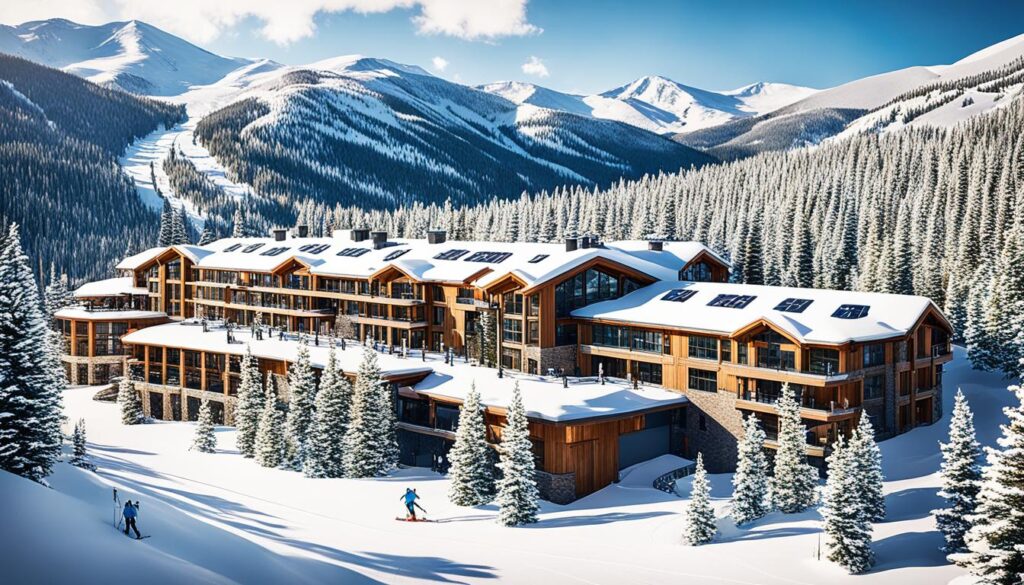
The Role of Weather Forecasting in Ski Season Planning
When it comes to planning ski seasons, weather forecasting plays a crucial role in helping us make informed decisions. Reliable snow forecasting and weather predictions are essential for skiers and ski resorts alike. Luckily, there are dedicated websites like OpenSnow that provide valuable information such as snow reports, travel advice, and accurate forecasts.
Meteorologists analyze various factors to predict snowfall and understand the potential impact on ski seasons. One of the factors they consider is the El Niño and La Niña patterns. These climate phenomena can influence snowfall patterns and help forecasters predict the likelihood of abundant snow or drier conditions.
Although seasonal forecasting is not always 100% accurate, advancements in machine learning and AI technologies are steadily improving forecast accuracy. However, it’s important to note that the best forecasts typically come 1-2 days in advance, with a decreasing level of accuracy beyond that.
“Weather forecasting allows us to plan ahead, make necessary preparations, and optimize ski experiences for both enthusiasts and resorts.”
For ski resorts, accurate weather forecasts enable them to efficiently manage their operations. They can prepare and allocate resources such as grooming equipment and snowmaking devices based on anticipated snowfall. Resorts can also adjust marketing efforts and communicate with skiers regarding optimal skiing conditions.
Here is a comprehensive table showcasing the crucial role of snow and weather forecasting in ski season planning:
| Benefits of Weather Forecasting in Ski Season Planning | Examples |
|---|---|
| Ability to make informed decisions | Deciding on the best days to ski based on snowfall predictions |
| Optimizing snowmaking operations | Timing snowmaking efforts to ensure optimal snow conditions on slopes |
| Maximizing safety | Advising skiers about potential weather hazards or unsafe conditions |
| Efficient resource allocation | Deploying grooming equipment or snowplows based on expected snowfall |
| Improved guest experience | Communicating accurate forecasts to skiers for better trip planning |
While weather forecasting plays a vital role in ski season planning, it’s important to stay aware of its limitations. Despite technological advancements, predicting weather patterns weeks or months in advance remains challenging. Therefore, it’s always a good idea to consult updated forecasts closer to your planned skiing dates for the most accurate information.
Key Takeaways:
- Weather forecasting is crucial for ski season planning.
- Websites like OpenSnow provide valuable snow reports, travel advice, and accurate forecasts.
- Meteorologists analyze factors like El Niño and La Niña patterns to predict snowfall and understand its impact on ski seasons.
- Advancements in machine learning and AI technologies are improving forecast accuracy.
- Weather forecasts help ski resorts efficiently manage operations, optimize snowmaking, and maximize safety.
- While seasonal forecasting has limitations, the best forecasts typically come 1-2 days in advance.
The Influence of El Niño and La Niña on Ski Seasons in Colorado
The occurrence of El Niño or La Niña can have an impact on ski seasons in Colorado. While there is no direct correlation between these climate patterns and snowfall in Colorado, stronger El Niño or La Niña events generally increase the chances of at least an average snow season.
“El Niño and La Niña can greatly influence the atmospheric patterns that determine snowfall across different regions. Although their effects on snowfall in Colorado are not as straightforward as in other areas, they do play a role in shaping the ski season.”
Historically, El Niño has brought higher-than-average snowfall in certain months, while La Niña has led to at or above median snowpack. This year is expected to be a moderate to strong El Niño, but the precise impact on snowfall is uncertain.
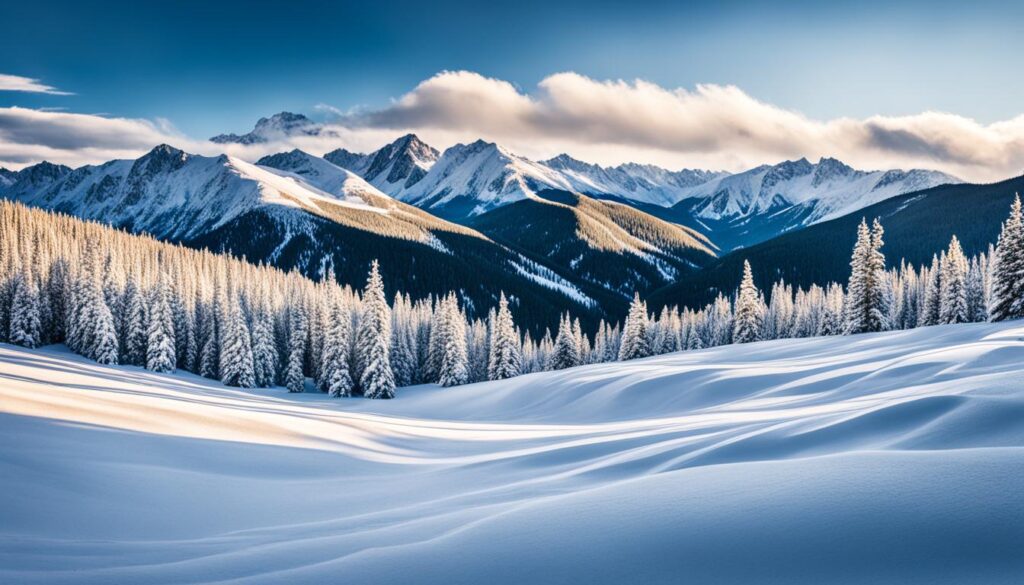
| El Niño | La Niña |
|---|---|
| Higher-than-average snowfall in certain months | At or above median snowpack |
| Variable impact on snowfall | Variable impact on snowfall |
Climate Change and its Potential Effects on Skiing in Colorado
While climate change may not directly impact the accuracy of weather forecasting, it can have long-term effects on ski seasons in Colorado. Warmer temperatures and reduced snowpack can lead to less snow at lower elevations, earlier snowmelt, and more rain during shoulder seasons. However, it’s important to note that there is no long-term trend in precipitation in Colorado. Climate change also raises concerns about the availability of water for snowmaking and the long-term viability of the skiing industry. These challenges highlight the need for continued efforts to address climate change and promote sustainability in the skiing industry.
The impact of climate change on ski seasons in Colorado has significant implications for the future of winter sports in the state. Ski resorts rely heavily on consistent snowfall and ideal skiing conditions to attract visitors and generate revenue. However, as temperatures rise and snowpack decreases, the traditional winter sports experience is at risk.
The warmer temperatures and reduced snowpack associated with climate change can have detrimental effects on the skiing industry, including shorter seasons, limited snow coverage, and compromised ski conditions. These changes not only affect the ski resorts themselves but also the surrounding communities that rely on winter tourism.
As the effects of climate change become more pronounced, ski resorts in Colorado are taking steps to mitigate these challenges. Many resorts are investing in innovative technologies such as snowmaking machines to supplement natural snowfall. These machines use highly pressurized water and compressed air to produce artificial snow, ensuring a consistent skiing experience even in the face of reduced snowpack.
Furthermore, ski resorts are implementing sustainable practices to reduce their carbon footprint and promote environmental stewardship. From adopting renewable energy sources to implementing recycling and composting programs, resorts are striving to minimize their impact on the environment while still offering memorable winter sports experiences.
To combat the potential long-term effects of climate change, collaboration between ski resorts, government agencies, and environmental organizations is crucial. By working together, we can develop strategies to reduce greenhouse gas emissions, conserve water resources, and protect the natural landscapes that make Colorado a world-renowned destination for winter sports.
Conclusion
The future of ski seasons in Colorado is greatly impacted by climate change and the measures being taken by ski resorts to address its effects. The skiing industry in Colorado has already experienced financial setbacks and shorter seasons as a result of these changes. However, resorts in the region are proactively investing in sustainable initiatives and innovative technologies to adapt to the evolving conditions.
One crucial aspect of ski season planning is weather forecasting, which plays a vital role in predicting snowfall and enabling resorts and skiers to make informed decisions. While seasonal forecasting still poses challenges, advancements in machine learning and AI are improving forecast accuracy. It is essential for resorts and skiers to leverage this tool to optimize skiing experiences and ensure safety on the slopes.
As climate change remains a pressing concern, it is imperative for the skiing industry in Colorado and individuals alike to take immediate action to reduce emissions and promote sustainability. By adopting environmentally-friendly practices and embracing renewable energy sources, we can help preserve the future of winter sports in Colorado for generations to come.
FAQ
How has climate change impacted ski resorts in Colorado?
Climate change has led to decreased snowfall, shorter ski seasons, and financial losses for ski resorts in Colorado. However, compared to other regions, the Rocky Mountain region has experienced the lowest losses so far.
What are ski resorts in Colorado doing to address sustainability?
Many ski resorts in Colorado are implementing sustainable initiatives such as composting, using solar energy, reducing waste, and restoring vegetation in resort areas. They are also investing in innovative technologies to reduce their environmental footprint.
How does weather forecasting play a role in ski season planning?
Weather forecasting provides snow reports, travel advice, and forecasts to help skiers and resorts make informed decisions. Meteorologists analyze factors like El Niño and La Niña patterns to predict snowfall and understand the potential impact on ski seasons.
What is the influence of El Niño and La Niña on ski seasons in Colorado?
While there is no direct correlation, stronger El Niño or La Niña events generally increase the chances of at least an average snow season in Colorado. El Niño has brought higher-than-average snowfall in certain months, while La Niña has led to at or above median snowpack.
How does climate change potentially affect skiing in Colorado?
Climate change can result in warmer temperatures, reduced snowpack, and earlier snowmelt, which can impact ski seasons in Colorado. It also raises concerns about water availability for snowmaking and the long-term viability of the skiing industry.
What is the future of ski seasons in Colorado?
The future of ski seasons in Colorado is influenced by climate change and the actions taken by ski resorts. While challenges exist, resorts are investing in sustainable initiatives and technologies to adapt to changing conditions and ensure the future of winter sports in Colorado.

